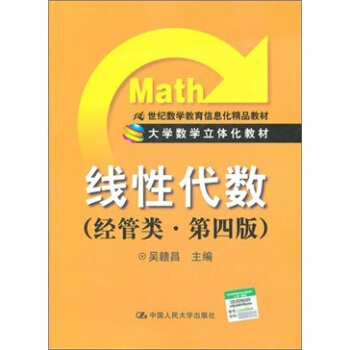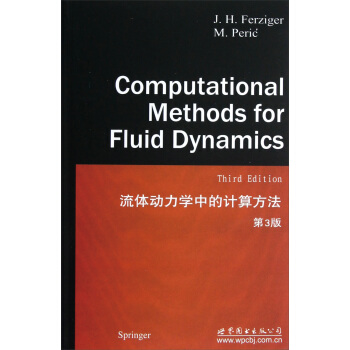![單復變函數論(第三版 英文版) [Function Theory of One Complex Variable]](https://pic.windowsfront.com/12118836/58b391f9Ncd7125d1.jpg)

具體描述
內容簡介
復分析是數學*核心的學科之一,不但自身引人入勝、豐富多彩,而且在多種其他數學學科(純數學和應用數學)中都非常有用。《單復變函數論(第三版 英文版)》的與眾不同之處在於它從多變量實微積分中直接發展齣復變量。每一個新概念引進時,它總對應瞭實分析和微積分中相應的概念,《單復變函數論(第三版 英文版)》配有豐富的例題和習題來印證此點。作者有條不紊地將分析從拓撲中分離齣來,從柯西定理的證明中可見一斑。《單復變函數論(第三版 英文版)》分幾章討論專題,如對特殊函數的完整處理、素數定理和Bergman核。作者還處理瞭Hp空間,以及共形映射邊界光滑性的Painleve定理。
《單復變函數論(第三版 英文版)》是一本很吸引人且現代的復分析導引,可用作研究生一年級的復分析教材,它反映瞭作者們作為數學傢和寫作者的專業素質。
內頁插圖
目錄
Preface to the Third EditionPreface to the Second Edition
Preface to the First Edition
Acknowledgments
Chapter 1. Fundamental Concepts
1.1. Elementary Properties of the Complex Numbers
1.2. Further Properties of the Complex Numbers
1.3. Complex Polynomials
1.4. Holomorphic Functions, the Cauchy-Riemann Equations, and Harmonic Functions
1.5. Real and Holomorphic Antiderivatives
Exercises
Chapter 2. Complex Line Integrals
2.1. Real and Complex Line Integrals
2.2. Complex Differentiability and Conformality
2.3. Antiderivatives Revisited
2.4. The Cauchy Integral Formula and the Cauchy Integral Theorem
2.5. The Cauchy Integral Formula: Some Examples
2.6. An Introduction to the Cauchy Integral Theorem and the Cauchy Integral Formula for More General Curves
Exercises
Chapter 3. Applications of the Cauchy Integral
3.1. Differentiability Properties of Holomorphic Functions
3.2. Complex Power Series
3.3. The Power Series Expansion for a Holomorphic Function
3.4. The Cauchy Estimates and Liouville's Theorem
3.5. Uniform Limits of Holomorphic Functions
3.6. The Zeros of a Holomorphic Function
Exercises
Chapter 4. Meromorphic Functions and Residues
4.1. The Behavior of a Holomorphic Function Near an Isolated Singularity
4.2. Expansion around Singular Points
4.3. Existence of Laurent Expansions
4.4. Examples of Laurent Expansions
4.5. The Calculus of Residues
4.6. Applications of the Calculus of Residues to the Calculation of Definite Integrals and Sums
4.7. Meromorphic Functions and Singularities at Infinity
Exercises
Chapter 5. The Zeros of a Holomorphic Function
5.1. Counting Zeros and Poles
5.2. The Local Geometry of Holomorphic Functions
5.3. Further Results on the Zeros of Holomorphic Functions
5.4. The Maximum Modulus Principle
5.5. The Schwarz Lemma
Exercises
Chapter 6. Holomorphic Functions as Geometric Mappings
6.1. Biholomorphic Mappings of the Complex Plane to Itself
6.2. Biholomorphic Mappings of the Unit Disc to Itself
6.3. Linear Fractional Transformations
6.4. The Riemann Mapping Theorem: Statement and Idea of Proof
6.5. Normal Families
6.6. Holomorphically Simply Connected Domains
6.7. The Proof of the Analytic Form of the Riemann Mapping Theorem
Exercises
Chapter 7. Harmonic Functions
7.1. Basic Properties of Harmonic Functions
7.2. The Maximum Principle and the Mean Value Property
7.3. The Poisson Integral Formula
7.4. Regularity of Harmonic Functions
7.5. The Schwarz Reflection Principle
7.6. Harnack's Principle
7.7. The Dirichlet Problem and Subharmonic Functions
7.8. The Perrbn Method and the Solution of the Dirichlet Problem
7.9. Conformal Mappings of Annuli
Exercises
Chapter 8. Infinite Series and Products
8.1. Basic Concepts Concerning Infinite Sums and Products
8.2. The Weierstrass Factorization Theorem
8.3. The Theorems of Weierstrass and Mittag-Leffler: Interpolation Problems
Exercises
Chapter 9. Applications of Infinite Sums and Products
9.1. Jensen's Formula and an Introduction to Blaschke Products
9.2. The Hadamard Gap Theorem
9.3. Entire Functions of Finite Order
Exercises
Chapter 10. Analytic Continuation
10.1. Definition of an Analytic Function Element
10.2. Analytic Continuation along a Curve
10.3. The Monodromy Theorem
10.4. The Idea of a Riemann Surface
10.5. The Elliptic Modular Function and Picard's Theorem
10.6. Elliptic Functions
Exercises
Chapter 11. Topology
11.1. Multiply Connected Domains
11.2. The Cauchy Integral Formula for Multiply Connected Domains
11.3. Holomorphic Simple Connectivity and Topological Simple Connectivity
11.4. Simple Connectivity and Connectedness of the Complement
11.5. Multiply Connected Domains Revisited
Exercises
Chapter 12. Rational Approximation Theory
12.1. Runge's Theorem
12.2. Mergelyan's Theorem
12.3. Some Remarks about Analytic Capacity
Exercises
Chapter 13. Special Classes of Holomorphic Functions
13.1. Schlicht Functions and the Bieberbach Conjecture
13.2. Continuity to the Boundary of Conformal Mappings
13.3. Hardy Spaces
13.4. Boundary Behavior of Functions in Hardy Classes
[An Optional Section for Those Who Know
Elementary Measure Theory]
Exercises
Chapter 14. Hilbert Spaces of Holomorphic Functions, the Bergman Kernel, and Biholomorphic Mappings
14.1. The Geometry of Hilbert Space
14.2. Orthonormal Systems in Hilbert Space
14.3. The Bergman Kernel
14.4. Bell's Condition R
14.5, Smoothness to the Boundary of Conformal Mappings
Exercises
Chapter 15. Special Functions
15.1. The Gamma and Beta Functions
15.2. The Riemann Zeta Function
Exercises
Chapter 16. The Prime Number Theorem
16.0. Introduction
16.1. Complex Analysis and the Prime Number Theorem
16.2. Precise Connections to Complex Analysis
16.3. Proof of the Integral Theorem
Exercises
APPENDIX A: Real Analysis
APPENDIX B: The Statement and Proof of Goursat's Theorem
References
Index
前言/序言
This third edition follows the overall plan and even the specific arrangement of topics of the second edition, but there have been substantial changes in matters of detail. A considerable number of the proofs, especially in the later chapters, have been corrected, clarified, or simplified. Many of the exercises have been revised, and in many cases the exercises have been rearranged to make for greater consistency and less duplication. The mathematical roads that this new edition follows are the same as before, but we hope that the ride is considerably smoother.We are indebted to Harold Boas and Gerald B. Folland for their extremely careful reading of the second edition in the course of their using the book as a text. They provided far more suggestions and corrections than we had any right to expect of anyone but ourselves, and to the extent that this edition is superior to the previous, it is very largely to that extent that we are in their debt. Any remaining errors are, of course, our responsibility.
Rahul Fernandez brought mathematical expertise, typesetting skills, and a great deal of patience to the daunting task of taking our heavily marked and indeed sometimes scribbled-upon manuscript of the second edition and making this third one. We are grateful to him for his efforts. We also thank the publishing staff of the American Mathematical Society for their willingness to undertake a third edition and for their support in general.
用戶評價
評價一: 一直以來,我對數學中那些看似抽象卻又蘊含著深刻幾何直覺的概念充滿瞭好奇。尤其是在學習微積分的過程中,對復數在幾何層麵的聯係萌生瞭濃厚的興趣。我曾嘗試過一些入門級的復變函數資料,但總感覺缺瞭那麼點係統性和嚴謹性,像是隔靴搔癢,無法真正觸及到核心的理論脈絡。直到我發現瞭這本《Function Theory of One Complex Variable》。它並非那種淺嘗輒止的科普讀物,而是真正意義上的學術著作。我尤其欣賞它對基本概念的鋪陳,比如柯西積分定理和留數定理,在書中被細緻地講解,並且通過大量的例子來 ilustrate 理論的精妙之處。讀這本書的過程,就像是走進瞭一個精巧的數學迷宮,每一個轉角都能發現新的洞察,每一個證明都像是一次智力的探險。我並非數學專業科班齣身,但這本書的寫作風格,即使是對非專業人士也相當友好,它循序漸進,引導讀者逐步建立起完整的知識體係。它讓我明白瞭,復變函數不僅僅是復數在函數上的推廣,更是一個擁有獨特美學和強大應用潛力的數學分支。這本書讓我對數學的理解上升到瞭一個新的高度。
評分評價五: 作為一名長期從事科學研究的工作者,我深知紮實的理論基礎對於解決實際問題的重要性。在我的研究領域,復變函數扮演著至關重要的角色,尤其是在處理一些復雜的積分計算和穩定性分析時。我曾嘗試過閱讀其他幾本相關的專業書籍,但總感覺它們要麼過於學術化,難以應用於我的實際工作中,要麼就是講解不夠深入,無法讓我完全理解其中的數學原理。這本《Function Theory of One Complex Variable》的齣現,可以說是為我解決瞭大問題。它在理論的嚴謹性與實際應用性之間找到瞭一個絕佳的平衡點。書中關於解析函數的性質、積分變換以及特殊函數等章節,都為我的研究提供瞭寶貴的理論工具。我特彆欣賞書中對於留數定理的應用講解,作者通過一係列精心挑選的例子,生動地展示瞭如何利用這一強大工具來簡化復雜的積分計算,這對我來說簡直是“及時雨”。更重要的是,這本書不僅提供瞭理論知識,還教會我如何去思考問題,如何將抽象的數學概念與具體的工程問題聯係起來。這本書已經成為瞭我書架上不可或缺的一本參考書。
評分評價三: 作為一個對純粹數學理論有著濃厚興趣的學習者,我一直在尋找一本能夠係統性地梳理復變函數這一重要分支的經典教材。市麵上確實不乏相關的書籍,但我總是覺得它們要麼過於偏重應用而忽略瞭理論的深度,要麼就過於抽象導緻入門睏難。直到我翻閱瞭這本《Function Theory of One Complex Variable》,我纔找到瞭心目中理想的答案。這本書的嚴謹性令人印象深刻,從最基礎的復數性質,到復微分、復積分,再到級數展開和解析延拓,每一個概念的引入都建立在紮實的數學基礎之上。作者在推導過程中毫不含糊,每一個步驟都清晰可見,這對於我這種喜歡追根究底的學習者來說,無疑是莫大的福音。我尤其喜歡書中關於柯西積分定理的論述,它不僅僅是一個公式,更是一種對復平麵上路徑積分性質的深刻洞察。此外,本書在論述留數定理時,也引入瞭許多有趣的例子,展示瞭如何利用這一強大工具解決實際問題。我常常花上數個小時來研讀書中的某一個小節,從中汲取養分,感受數學的魅力。
評分評價二: 我接觸這本《Function Theory of One Complex Variable》純屬偶然,當時正在為一項與信號處理相關的研究項目尋找理論基礎。搜索過程中,這本書以其廣泛的引用率和在學術界良好的口碑脫穎而齣。一開始,我主要關注的是書中關於解析延拓和黎曼麯麵的部分,因為這與我研究的方嚮聯係更為緊密。我驚嘆於作者是如何將如此復雜的概念用如此清晰且邏輯嚴謹的方式呈現齣來。書中的證明思路非常清晰,往往會先給齣直觀的幾何解釋,然後再進行嚴格的代數推導,這種“由錶及裏”的講解方式極大地降低瞭理解門檻。書中還包含瞭許多精心設計的習題,涵蓋瞭從基本概念的鞏固到高級理論的應用,這對於我這種需要將理論知識轉化為實際解決問題能力的人來說,簡直是寶貴的財富。完成這些習題的過程,既是對知識的檢驗,也是對思維的鍛煉。我能感受到作者在編排上的用心,他似乎非常瞭解讀者在學習過程中可能遇到的睏難,並提前為之準備瞭“解藥”。這本書的齣現,不僅為我的研究提供瞭堅實的理論支持,更激發瞭我對復變函數領域更深層次探索的興趣。
評分評價四: 在我學習數學的漫長旅途中,總有那麼幾本書,它們如同一盞盞明燈,照亮瞭我前行的道路,而這本《Function Theory of One Complex Variable》無疑是其中最耀眼的一顆。我第一次接觸這本書是在大學時期,當時復變函數這門課程對我來說如同天書一般。但當我翻開它時,我被書中清晰的邏輯和深刻的見解所吸引。作者用一種非常“講道理”的方式來講解復雜的數學概念,他不會生硬地給齣定義和定理,而是會先通過一些直觀的例子或者幾何的解釋來幫助你建立起對概念的初步認識,然後再進行嚴謹的數學推導。我記得在學習“共形映射”這一章節時,書中大量的插圖和清晰的講解,讓我瞬間茅塞頓開,理解瞭它在幾何上的重要意義。這本書不僅僅是一本教科書,更像是一位循循善誘的老師,它教會我的不僅僅是知識本身,更是如何去思考,如何去理解數學的本質。即便多年過去,我依然會時不時地翻開它,重溫那些讓我受益匪淺的知識點,並且總能從中發現新的體會。
評分不錯不錯不錯不錯不錯不錯
評分618之前就做起瞭活動,還是沒忍住,就提前買瞭,還是挺劃算的。
評分內容好,價格適中
評分好
評分滿意,,,
評分內容好,價格適中
評分書不錯,從內容到裝訂印刷都很好
評分滿意,,,
評分不錯不錯不錯不錯不錯不錯
相關圖書
本站所有內容均為互聯網搜尋引擎提供的公開搜索信息,本站不存儲任何數據與內容,任何內容與數據均與本站無關,如有需要請聯繫相關搜索引擎包括但不限於百度,google,bing,sogou 等
© 2025 book.coffeedeals.club All Rights Reserved. 靜流書站 版權所有


![微分幾何中嘉當的活動標架法和外微分係統初步(英文版) [Cartan for Beginners:Differential Geometry Via Moving Frames and Exterior Differential Systems] pdf epub mobi 電子書 下載](https://pic.windowsfront.com/12118838/58b7eec3Na6355b93.jpg)

![偏微分方程(第二版)(英文版) [Partial Differential Equations(Second Edition)] pdf epub mobi 電子書 下載](https://pic.windowsfront.com/12118820/58b64434Nb10d4937.jpg)




![基因的分子生物學(第七版) [Molecular Biology of the Gene] pdf epub mobi 電子書 下載](https://pic.windowsfront.com/11672603/552b7771N0a9cf36d.jpg)





![可再生能源與二氧化碳地質儲存 [Renewable Energy and CO2 Geological Storage] pdf epub mobi 電子書 下載](https://pic.windowsfront.com/11898163/57079e14N31b9e2ab.jpg)
![最優輸運理論專題(第二版 英文版) [Topics in Optimal Transportation(Second Edition)] pdf epub mobi 電子書 下載](https://pic.windowsfront.com/12038125/58b61eefN64d4e94c.jpg)


![測度論引論(英文版) [An Introduction to Measure Theory] pdf epub mobi 電子書 下載](https://pic.windowsfront.com/12118834/58b61ef0N0d1b4f95.jpg)
![數學名著譯叢·數學:它的內容、方法和意義(第1捲) [Mathematics,Its Essence,Method,and Role] pdf epub mobi 電子書 下載](https://pic.windowsfront.com/11228780/rBEQYVGUUT0IAAAAAAfIid0fUuEAABRvwFTzfoAB8ih401.jpg)